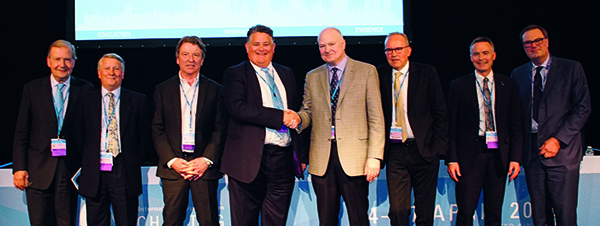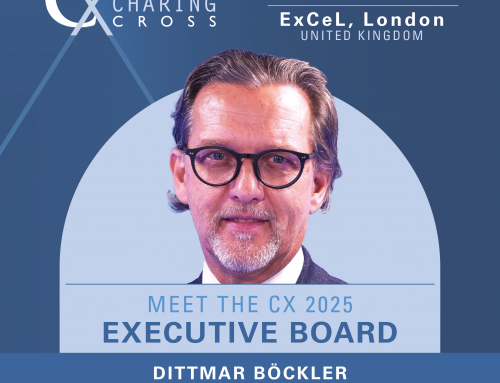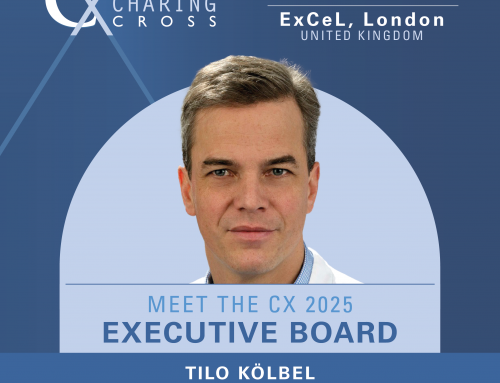
CX 2018 Dragons’ Den winner, Kieran Murphy, with the Dragons
The Innovation Showcase yesterday brought together the CX values of education, innovation, and evidence to paint a global picture of vascular entrepreneurship, highlighting the controversies currently threatening the next generation of game-changing products.
Beginning the day with innovation and regulation controversies, key opinion leaders provided a grim outlook for the future of truly disruptive technologies and products emerging from the European vascular marketplace. Later on, discussions of peripheral, aortic, venous, vascular access, diagnostic and imaging innovations provided insight into cutting-edge developments in each of these fields.
The golden age of innovation in Europe is coming to an end
Following the introduction of the European Medical Device Regulation (EU MDR) legislation, panelists Gido Karges (Wangs, Switzerland) and Jeffrey Jump (Mont-sur-Rolle, Switzerland) fear that the pace and scale of vascular innovation in Europe will be diminished, with Jump going so far as saying “the golden age of innovation in Europe is coming to an end”.
Karges referred to the EU MDR as “one of the most impactful pieces of legislation”. In 2008, legislators aimed to establish a robust, transparent, predictable and sustainable regulatory framework for medical devices in the EU, improving health and safety while supporting innovation. However, in 2010, a criminal fraud case caused a public scandal that, according to Karges, meant “some politicians saw a chance to make a name for themselves, and triggered harsh reactions to isolated cases of fraud or misconduct of very few manufacturers”. This provided impetus for the EU MDR.
MDR is replacing the Medical Device Directive (MDD). The MDR has been in force since 25 May 2017, and a three-year transition period applies. Current MDD certificates remain valid, but cannot be renewed. This means that from 27 May 2020 onwards, all medical devices brought to market in the EU and Switzerland must conform to the MDR.
Karges explained the ramifications: “Expenditures associated with MDR compliance are enormous. Due to these costs, device developers will need to make choices about which areas of their business to remediate first. Some may decide the costs of remediation exceed the business opportunity, choosing to sell or close down certain product lines. As manufacturers decide to discontinue legacy products, suppliers go out of business, dragging other manufacturers who bought from them behind. German and Swiss health authorities predict the extinction of 30% of all medical device manufacturers. They also expect that 50% of all medical devices will be discontinued or fail to meet the requirements. Patients might be at risk—it is a very grim outlook.”
According to Jump, the estimated additional cost for manufacturers is €12–17 billion. While the European healthcare arena is experiencing significant change, Jump explains that “The FDA and other competent authorities have released new regulations and guidelines in order to decrease the burden of getting market access for innovative medical devices.”
Jump summarised, “Europe is now heading in the opposite direction, particularly for innovative products. Due to the uncertainty of MDR implementation and interpretation, increased cost of compliance, fragmented distribution and divergent reimbursement policies, the 40-year-old model of ‘go to Europe first’ will be challenged. Europe may have to wait for innovative medical devices to be proven safe and effective in other markets before European patients will have access to improved technologies. I believe innovators will follow the path of least resistance and vote with their feet.”
Coramed antioxidant premedication announced as CX Dragon’s Den 2018 winner
In the spirit of showcasing innovation within the vascular industry, yesterday’s session included a Dragons’ Den panel, awarding Kieran Murphy (Toronto, Canada) this year’s winner. The prestige value attached to being recognised as the developer of the most promising innovation in vascular medicine has allowed the three previous winners of the £1,000 prize to gain additional funding for their product.
In what Dragon Chas Taylor (Horsham, UK) called “The best Dragon’s Den line-up” of any CX, eight innovators pitched their idea to the panel. In addition to Taylor, the panel consisted of Greenhalgh, Frans Moll (Utrecht, The Netherlands), Andrew Holden (Aukland, New Zealand), Bob Mitchell (Irvine, USA), Daveen Chopra (Santa Rosa, USA), and Alan Edwards (Ruthin, UK).
Murphy’s winning presentation was on the use of antioxidant premedication for patients, physicians, and aircraft crew. These are all people exposed to above average levels of radiation; Murphy explained how antioxidants prevent DNA damage caused by excessive radiation. Murphy and colleagues have preliminary FDA guidance, and prospective randomised human studies are positive. Murphy identified the addressable market size as approximately US$600 million a year.
The runner-up was Martin Czemy (Freiburg, Germany) with his non-occlusive TEVAR moulding balloon.
There were also two honourable mentions: one for Elchanan Bruckheimer (Petach Tikva, Israel), for his use of holography in clinical interventions, and one for Colin Henehan (Galway, Ireland) for his Tulip device.







